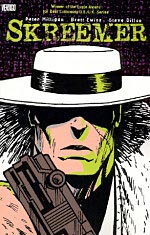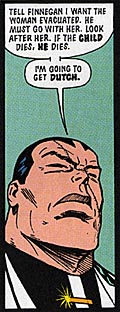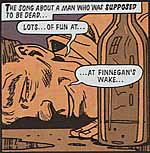>> Thumbnail: Alan Moore
>> Snake Charmer: An interview with Alan Moore, Part Two
More...

 Writer: Peter Milligan
Writer: Peter Milligan
Artists: Brett Ewins, Steve Dillon
Price: £14.99 / $19.95
Publisher: Titan Books / DC Vertigo
ISBN: 1-84023-485-7 / 1-56389-925-6
Peter Milligan is doing well for himself these days. X-FORCE/X-STATIX remains one of "New Marvel's" biggest successes, racking up critical accolades and generating the sort of controversy that only ever results in increased sales. Rolling Stone and Entertainment Weekly have done stories on Milligan, the crowds lined up for his autograph at Comic Con International this year rivalled Grant Morrison's, and Wizard magazine recently nominated him as "Best New Writer" - even though he's been steadily working in mainstream comics for a decade. Considering Milligan's recent success, it was only a matter of time before DC/Vertigo began reprinting his earlier, creator-owned work, starting with the multi-award-winning miniseries, SKREEMER.
SKREEMER is described by its authors as a "retro sci-fi gangster story," set in a future world that strikingly resembles America in the 1930s. Jet packs and rayguns have been shunned in favour of Rolls Royces and Thompsons. The rich women wear furs. The poor ones, rags. There is no in-between.
After an unspecified catastrophe - dramatically referred to as "The Fall" - America plunges into a decades-long depression, marked by political anarchy and gangland violence. Bootleggers and crimelords, ironically known as "Presidents", rule the remaining city states by controlling the flow of liquor and medicine. Whenever their authority is challenged, the Presidents rely on a stable of brutal hitmen called "Skreemers."
One of these thugs, a particularly vicious little bastard named Veto, eventually rises through the ranks of the criminal world, eliminating competitor after competitor until he's no longer a mere Skreemer, but The Skreemer. The only one left. Through the eyes of an unseen narrator, recounting events that occurred decades before his birth, we watch as Veto struggles desperately to hold onto his crumbling empire in the face of sweeping social change.
 Providing the story's counterpoint is Charlie Finnegan, a working-class schlub with a heart of gold, trying his best to stay righteous in a thoroughly corrupt world, a world run by men like Skreemer. Finnegan is an enormously sympathetic character; straight out of a Steinbeck novel. The nearly absurd level of tragedy in his life is offset by his unfailingly hopeful attitude and his struggle to remain human in a world where monsters get all the breaks.
Providing the story's counterpoint is Charlie Finnegan, a working-class schlub with a heart of gold, trying his best to stay righteous in a thoroughly corrupt world, a world run by men like Skreemer. Finnegan is an enormously sympathetic character; straight out of a Steinbeck novel. The nearly absurd level of tragedy in his life is offset by his unfailingly hopeful attitude and his struggle to remain human in a world where monsters get all the breaks.
At its heart, SKREEMER is a straightforward rise-and-fall story in the tradition of GOODFELLAS or SCARFACE, but what sets SKREEMER apart from the pack is the innovative way in which it is written. Milligan employs a disjointed, cut-and-paste storytelling style, hopping from time to time and place to place in a manner that's not so much William S Burroughs as it is James Joyce.
Milligan flaunts his knowledge of 20th Century literature throughout SKREEMER. The book succeeds in capturing the grim-yet-hopeful feel of classic Depression-era novels, from John Steinbeck's blue-collar epics to pulp gangster stories. FINNEGAN'S WAKE, both the novel and the song, figure prominently in the story, and Milligan manages to cleverly mimic Joyce's bizarre storytelling style throughout the book, as well as the styles of other Modernist writers like Virginia Woolf and Gertrude Stein. George Orwell, TS Eliot, and W Somerset Maugham are all heavily referenced as well.
In the hands of a lesser writer, all this literary blah-blah would seem like pure pretension - a pointless exercise in cleverness designed to make the reader feel as stupid as possible. But Milligan manages to pull it all together, producing a thoroughly entertaining story that doesn't require a degree in literature to be enjoyed.
 It's perhaps worth noting that SKREEMER's world is designed to resemble the era that spawned the Modernist movement itself - the bleak despair of the 1930s that forced poets, artists, and writers all over the world to seek out something new, something different. The characters in SKREEMER all share that same desperate longing, and echoes of the Depression era resonate throughout the book. Even Veto's appearance - vaguely reminiscent of the stylised über-workers seen in Soviet propaganda posters - seems antiquated, historical, larger than life.
It's perhaps worth noting that SKREEMER's world is designed to resemble the era that spawned the Modernist movement itself - the bleak despair of the 1930s that forced poets, artists, and writers all over the world to seek out something new, something different. The characters in SKREEMER all share that same desperate longing, and echoes of the Depression era resonate throughout the book. Even Veto's appearance - vaguely reminiscent of the stylised über-workers seen in Soviet propaganda posters - seems antiquated, historical, larger than life.
All of this is fitting, as the plot concerns the end of an historical era. More simply put, though, it's a book about change - about death and rebirth.
The measured repetition of the lyrics to FINNEGAN'S WAKE (an old Irish drinking song about a dead man brought back to life by whiskey) frames this theme perfectly and gives the reader something to hold onto while the story's narration whips about in every direction.
Brett Ewins' pencils take a little getting used to, and Steve Dillon's scratchy inks are a far cry from the controlled realism of his post-HELLBLAZER work, but the overall design of the book suits the story perfectly. Veto is all shoulders and cold intimidation, growing physically larger and more exaggerated as his empire grows. Skreemer's presidential mansion is rendered with all the distant surrealism it deserves, and the sad eyes of Charlie Finnegan break your heart in every panel.
SKREEMER is a tough read. There's no sense in pretending it's not. Its disjointed, time-hopping construction and Brechtian dialogue make it a bit difficult to follow, especially in the first few chapters. Imagine someone handing you random pieces of a jigsaw puzzle and then leaving you to figure out where they go. That's what SKREEMER feels like. But unlike similarly experimental comics like THE INVISIBLES or SHADE, you do get all the pieces eventually, and the picture they form will stay with you. Like an old song.

This article is Ideological Freeware. The author grants permission for its reproduction and redistribution by private individuals on condition that the author and source of the article are clearly shown, no charge is made, and the whole article is reproduced intact, including this notice.


